ASUS P8Z68-V PRO Review: Our First Z68 Motherboard
by Ian Cutress on May 11, 2011 3:13 AM EST- Posted in
- Motherboards
- Asus
- Z68
3D Movement Algorithm Test
The first benchmark ran is actually one I have written. My full time job involves computational chemistry, so this first benchmark uses various algorithms for three-dimensional simulation and movement of independent particles. The algorithms both employ uniform random number generation or normal distribution random number generation, and vary in various amounts of trigonometric operations, conditional statements, generation and rejection, fused operations, etc. The benchmark runs through six algorithms for a specified number of particles and steps, and calculates the speed of each algorithm, then sums them all for a final score. This is an example of a real world situation that a computational scientist may find themselves in, rather than a pure synthetic benchmark. The benchmark is also parallel between particles simulated, and we test the single thread performance as well as the multi-threaded performance.
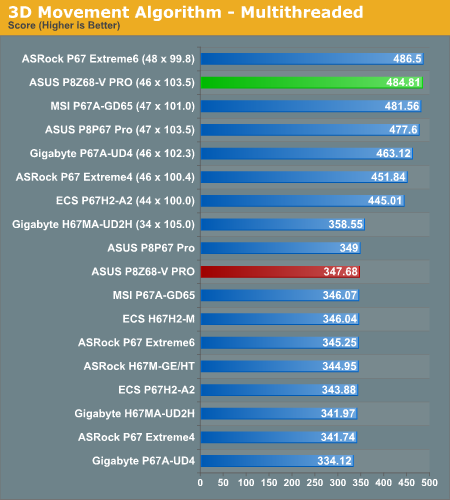
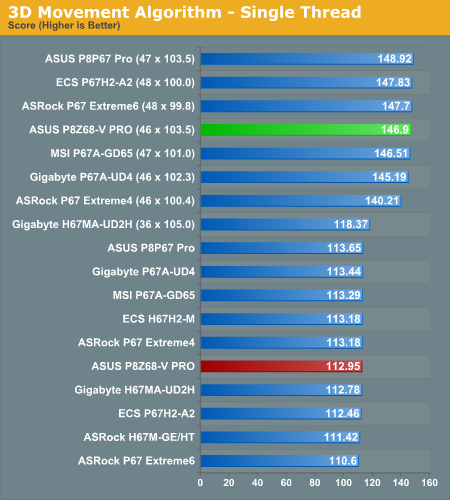
WinRAR x64 3.93
With 64-bit WinRAR, we compress the set of files used in the USB speed tests. WinRAR x64 3.93 attempts to use multithreading when possible.
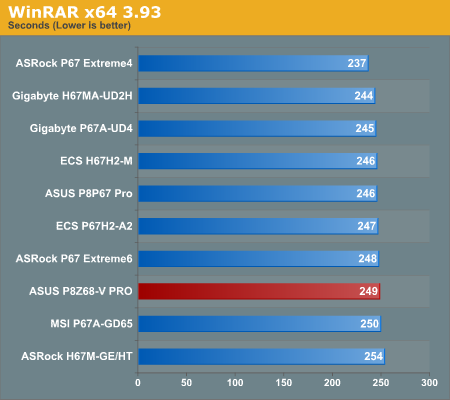
FastStone Image Viewer 4.2
FastStone Image Viewer is a free piece of software I have been using for quite a few years now. It allows quick viewing of flat images, as well as resizing, changing color depth, adding simple text or simple filters. It also has a bulk image conversion tool, which we use here. The software currently operates only in single-thread mode, which should change in later versions of the software. For this test, we convert a series of 170 files, of various resolutions, dimensions and types (of a total size of 163MB), all to the .gif format of 640x480 dimensions.
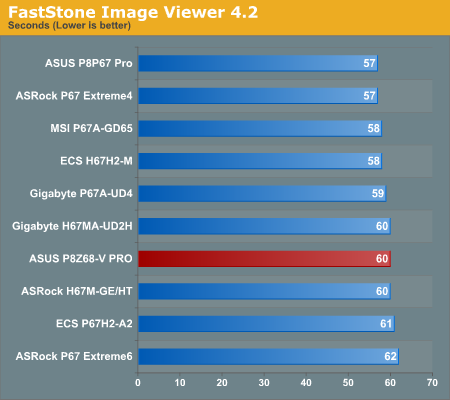
Sorenson Squeeze 6.0
Sorenson Squeeze is a professional video encoder, complete with a vast array of options. For this test, we convert 32 HD videos, each a minute long and approximately 42 MB in size, to WMV 512KBps format. Squeeze can encode multiple videos at once, one for each thread.
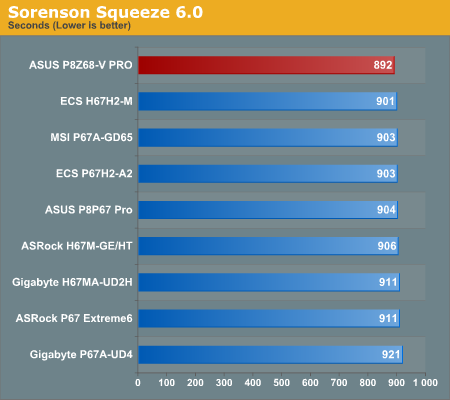
The ASUS does relatively well in our Computation bench suite, with an excellent Squeeze score. It's not the fastest board so far, but the difference between the slowest and fastest board in each test is only 3-9%, so for stock performance it's not something generally noticeable in day to day use.










95 Comments
View All Comments
BernardP - Wednesday, May 11, 2011 - link
A practical question: If one wants to use i-mode or d-mode, is it necessary to install both the Intel video driver and the AMD or Nvidia video driver?Could this be a source of conflicts or other problems?
AnnihilatorX - Thursday, May 12, 2011 - link
Yes you need to install both. Not really on Vista and Windows 7, new driver models mean you can install multiple GPU drivers. I don't think Virtu supports older OS.BernardP - Thursday, May 12, 2011 - link
Thanks for the reply. Noted for future. After taking everything into consideration, including my usage pattern, I would simply deactivate intel IGP, not install Virtu and add an entry-level Nvidia videocard, such as the fanless Asus GT 520.The noteworthy other Z68 feature is SSD cache, but after reading the detailed article about this, I would prefer to go with a 120 GB SDD plus mirroring HDDs.
For me the single plus of the Z68 platform is that I would have Intel IGP as a temporary backup in case of failure of the discrete GPU. This is only worth a very small premium over P67.
vol7ron - Wednesday, May 11, 2011 - link
When you refer to BIOS, do you mean the UEFI BIOS Utility, or is there a dual BIOS/UEFI boot option?risa2000 - Wednesday, May 11, 2011 - link
I noticed in test setup description three different memory modules. Did you do some tests on memory throughput? Was there any difference?I wonder if it makes sense to go for faster memory beyond DDR3-1600.
AnnihilatorX - Thursday, May 12, 2011 - link
You are looking at about 2-5% performance increase from going DDR 1600 to DDR 2133No point buying expensive RAM unless you spot a bargain
L. - Thursday, May 12, 2011 - link
"expensive RAM" -- on the other hand there's quite a lot of relatively cheap around 2k mhz -- sticking to 1600 isn't that great nowadays.cyklonman - Wednesday, May 11, 2011 - link
P67 Asus looks much better, why did I wait for this one?fr500 - Wednesday, May 11, 2011 - link
Will this work?Hook up a monitor with two inputs and connecting a spare input to the motherboard's connector? As far as I know all you need is a display hooked up to one of the motherboard connectors, so if you have a display with 2+ inputs you could get one to your IGP, one to your GPU and switch to the IGP input when you want to do transcoding.
Best of both worlds, intact GPU performance and Quicksync.
Even if Virtu works 100% it still won't let you use your GPU control panel and any crashes might be harder to diagnose (ie: who should I blame, Lucid or NVidia/AMD)
Ryan Smith - Thursday, May 12, 2011 - link
Sure, that should work. Windows may or may not have quirks though, based on past experience.As for the control panel thing, I have not used Virtu in dGPU mode, but based on how Hydra works I'm sure the AMD/NV control panels work in dGPU mode. I wouldn't expect any crashes in that mode either since Virtu isn't intercepting the dGPU, but again I classify that with the fact that I haven't used dGPU mode yet.